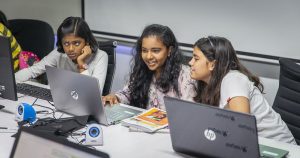
4th October 2019
3 simple ways to move from block- to text-based programming
As you return #BackToDojo, you may be wondering how to challenge and engage your older Ninjas.
Most Ninjas begin their learning journey with Scratch. It’s visual and delivers immediate results — perfect for beginners! However, as time goes on they may want to create projects that simply cannot be achieved using Scratch. Making the transition to a text-based language, such as Python, can help to unlock creative potential for older Ninjas. This will in turn keep them engaged at your club.
1. Share real examples
Young people may find new concepts hard to understand until they can see examples of how they are used. Showing real-world examples can help.
An example could be a project another young person at the Dojo is working on, a past Coolest Projects entry, or even a popular website. Choose examples that appeal to the young person’s interests, or identify a topic or theme that interests them, e.g., the environment, outer space, and use that as a starting point.
2. Develop literacy and keyboard skills
Children may find transitioning to a text-based language tricky while still developing their grasp of literacy. Limited experience of using a keyboard can make this doubly challenging. It’s useful to encourage keyboard skills early on while they are still using Scratch!
Truly, what is the barrier to text programming? It isn’t conceptual, since students can grasp variables, conditionals, loops, and functions in block-based interfaces.
When we come right down to it, the barrier is that students have to type and read code — Michael Taggart (source)
Be patient when encouraging Ninjas to type their code and avoid the temptation to take over the keyboard. We have a CoderDojo motto for adults: “Be hands-on, but keep your hands off the keyboard!”
3. Tools and training
There are a number of online resources to help you. Our course ‘Scratch to Python: Moving from Block- to Text-based Programming’ shows educators how to reapply their knowledge of teaching Scratch, as well as providing a basic introduction to Python.
The open-source Python editor Mu is a simple editor developed by musician Nicholas Tollervey, and our colleague Carrie Anne Philbin. Tollervey designed it for students based on his own approach to teaching music. Editors like Mu allow learners to create and test their code within a pleasant interface.
Lastly, young people can use the block-based tool EduBlocks for transitioning to text-based languages — perfect for younger Ninjas who are still developing their keyboard skills. Teenager Joshua Lowe was inspired to develop the platform after noticing his friends struggling with text-based languages. You can listen to Joshua’s talk, ‘Making the transition to Python easier,’ at the Euro Python Conference here.


